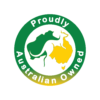Adhesives
GLUES:
We all have our favourites. There are many adhesives available to the mosaicist. I prefer using glues that can handle most situations, so do not recommend indoor only adhesives (for example). I also prefer to support Australian products where I can.
PVA (Poly-Vinyl Adhesive) :
These are usually suitable for indoor only and will re-emulsify in water or humid conditions. They are white when wet, but dry clear. Common brands are Weldbond (Canada) or Selleys Aquadhere. Aquadhere is much cheaper. Unfortunately, whilst developed in Australia, Selleys is no longer Australian owned, but is part of the Dulux group (under Japanese ownership). Available from most hardware stores. Not neutral curing. PVAs can be diluted and used as a wash to minimise the effect of Grout Bleed.
MAC :
An American glue developed by an artist specifically for Glass-on-Glass mosaic. White when wet, dries clear. Use sparingly, do not shake. Available in Australia from Peter Twining (treasuryroad.com.au). Does not tolerate low temperatures when wet. Must clean up before it cures. Not stated as neutral curing, but anecdotally it is once dried. Waterproof once cured.
At time of writing MAC are experiencing difficulty sourcing a major component of the glue. Until a suitable replacement is found, MAC is not in production. Treasury Road (Australia) currently does have saleable stock.
PREP MULTI-USE ADHESIVE :
an Australian Styrene glue. Weather Resistant. White when wet, dries clear. Will soften after prolonged exposure to moisture. Can be diluted with water and used as a sealant/bonding agent. Clean up after curing with acetone. Neutral curing. Sold by Merlin Mosaica, and Mitre 10. Not suggested as a treatment against Grout Bleed, as once dry it forms a film that can be fiddly to remove.
CEMENTITIOUS ADHESIVE :
Known as Thinset in the US (and on many Facebook mosaic sites). Also known as Tilers Cement. A cementitious powder mixed with either water or a latex liquid (Admix) for added strength. Some are rated interior only, and some are for porous tesserae only (i.e. not glass). Not advised for use on MDF, timber, acrylic or glass substrates. Comes in grey or white, can be coloured with cement pigments/oxides. Not neutral curing.
SILICONE :
There are many brands (Sika, Parfix, Selleys). Readily available from most hardware stores. Usually supplied in a caulking tube for use with a Caulking Gun. Silicone contains toxins that continue to be off-gassed during the curing process. May be harmful or irritating to those with chemical sensitivities. Make sure you use in well-ventilated areas. Usually waterproof, but not always submersible. SOME are neutral curing. The pre-cure solvent is Isopropyl Alcohol. After curing, removal is done with a sharp blade (eg Razor Blade).
POLYMER :
A less toxic option to silicone. Handles pretty much the same way as silicone but is much less harmful. It is a neutral cure adhesive. I sell the Soudal range of Fix-all SMX Polymers at Merlin Mosaica in Clear, White, Grey and Black. Fix-all (and T-Rex) are slightly thicker than silicone, but are excellent products. The pre-cure solvent is Isopropyl Alcohol. After curing, removal is done with a sharp blade (eg Razor Blade). Can be used in most situations, but not recommended for submersion (See below).
HEAT ACTIVATED MOSAIC FILM :
This is a specialist adhesive which I sell at Merlin Mosaica. It is suitable for inside or exterior use. It is submersible and neutral cure. Not recommended for curved or 3D substrates.
SUBMERSIBLE or NOT SUBMERSIBLE??
Many glues are not rated as waterproof, or are not recommended for submersion. However, the manufacturers are not usually considering the use of a grout layer.
The majority of mosaics that are likely to be submerged (think bird or bee baths) are GROUTED. If a waterproof grout is used, AND all joints and edges are fully covered, with no cracks, then the range of glues that can be used successfully increases.
What is NEUTRAL CURING, and why is it important?
All adhesives release chemicals as they cure, even a simple water-based one (after all, water is a combination of 2 elements – hydrogen & oxygen).
Neutral cure adhesives release a non-acidic substance while curing (unlike acetoxy caulks which release acetic acid). This is less likely to damage sensitive surfaces and substrates. For example, neutral cure is gentle enough not to discolour natural stone or corrode any metals.
In mosaics, this is particularly important when working with mirror. Mirror is glass that has been treated on the back face with a reflective film. Mirrors are produced by the wet deposition of silver, or sometimes nickel or chromium (the latter used most often in automotive mirrors) via electroplating directly onto the glass substrate. Glass mirrors for optical instruments are usually produced by vacuum deposition methods. So, it is important to protect this film from the corrosive effects of acetone or other acidic substances.
Don’t forget, mirrored tiles are often made the same way.
NOTE: Van Gogh glass is glass treated with an automotive paint. To my knowledge, it should also be used with a Neutral Cure adhesive.
Don’t forget, mirrored tiles are often made the same way.
NOTE: Van Gogh glass is glass treated with an automotive paint. To my knowledge, it should also be used with a Neutral Cure adhesive.
Find our range of adhesives here






Leave a Reply
Want to join the discussion?Feel free to contribute!